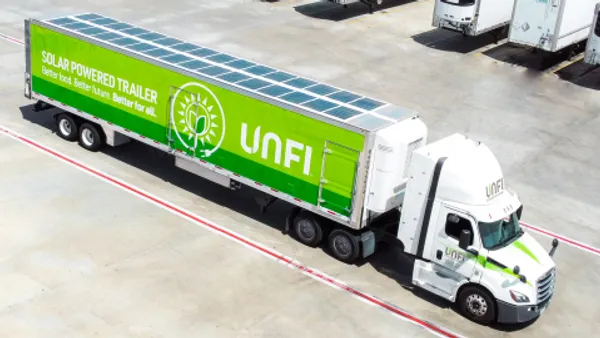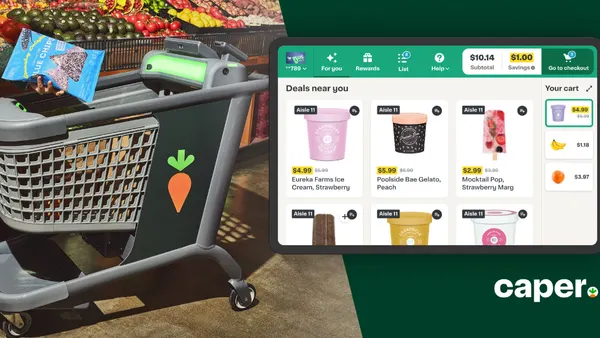As tech startup Udelv approaches its thousandth autonomous delivery for Walmart in Surprise, Arizona, director of business development Adriel Lubarsky believes the service has a role to play in solving a problem that has long bedeviled retailers, legislators and advocacy groups alike: food deserts.
Lubarsky points out that autonomous grocery delivery can meet shoppers at whatever time and place suits them. And because it factors out labor costs while boosting efficiency for route planning and gas mileage, it comes at low or even no cost to consumers.
"Once we’re able to figure out the mold or the kick of what autonomous grocery delivery needs to look like, well then a company like Walmart or any other grocer can take this knowledge, take the tools that we provide, and offer that to a community elsewhere that needs it," Lubarsky told Grocery Dive in an interview.
America's food deserts have proven resistant to innovation in the past, with efforts like mobile grocery trucks and community gardens making at best a small dent in the problem. Now, the private and public sectors are betting on technology to provide solutions for the 37 million Americans living in neighborhoods without ready access to fresh foods.
Last month, the U.S. Department of Agriculture launched a two-year pilot program in New York State allowing Supplemental Nutrition Assistance Program (SNAP) recipients to purchase groceries online. If the program proves successful, the USDA will expand it to several other states. Lyft has launched a Grocery Access program to offer affordable rides to grocery stores for people living in food deserts, and meal delivery services are pursuing fresh, affordable delivery to combat chronic disease.
However, effectively reaching shoppers in underserved areas — and at a scale and cost that are sustainable — is still a daunting prospect.
Discount rides and home delivery
Lyft, the ride share company that claims 35% of the U.S. ride-hailing market and provides more than 1 million rides a day, began piloting discounted rides to shoppers in Washington, D.C. food deserts in January. Through the program, Lyft partnered with local nonprofit Martha’s Table to identify areas of need and then provide rides for $2.50 each way. Riders can access their discounted rides through the Lyft app using a unique code or through a discount added to their account when they register.
After the pilot in the nation’s capital, Lyft announced in April that it would expand the program to 15 cities in the U.S. and Canada. Eventually, Lyft would like to offer the program to both rural and urban communities nationwide.
"The pilot in D.C. was really successful," Mike Masserman, head of social impact for Lyft, told Grocery Dive in an interview. "We did thousands of rides, and we saw that this was a need in communities all across the U.S. and that’s why we decided to expand this to more than a dozen additional cities, with many more to come."
Lyft plans to partner with local nonprofits and grocers in the new cities to help identify participants for the program. In Miami, Lyft will work with Health in the Hood and Bravo Supermarkets. In New Jersey, Lyft has partnered with the Community Food Bank of New Jersey and ShopRite, and in Atlanta it will work with the Georgia Farmers Market Association.
Grocery stores are not going to be program partners in every city and do not receive any exclusive benefits or financial incentives, but Masserman said in some cases they are involved because they have knowledge of the market that is critical to the program’s success.
"We did thousands of rides, and we saw that this was a need in communities all across the U.S. and that’s why we decided to expand this to more than a dozen additional cities, with many more to come."

Mike Masserman
Head of social impact for Lyft
"Our focus right now is really identifying who are the most impactful local partners who can help us identify the right folks on the ground to execute these programs," Masserman said.
In addition to being food deserts, these areas are also often transportation deserts. Pricing for Lyft rides through the Grocery Access Program will vary by community, and the company is creating subsidies that will match prices closest to the cost of taking public transportation in each area, Masserman said.
For the USDA's e-commerce pilot with SNAP, Walmart, ShopRite and Amazon have signed on. Other retailers are on deck to participate in the program as it rolls out to more pilot states including Alabama, Iowa, Maryland, Nebraska, New Jersey, Oregon and Washington. With the pilot, the USDA will be able to ensure online transactions are processed safely and securely before national implementation.
In an email to Grocery Dive, an Amazon spokesperson said that the company recognizes that customers on government assistance tend to be part of an underserved audience. Many customers, the spokesperson said, have expressed interest in using online shopping to further extend their SNAP benefits.
"The online pilot is about ensuring that the opportunity to order groceries online is available to all," an Amazon spokesperson wrote.
A complex problem to solve
While online grocery, autonomous delivery and affordable transportation seem promising at the outset, there are still barriers for customers in these areas.
Beth Racine, a professor of public health at the University of North Carolina at Charlotte, is conducting research on food deserts and has analyzed years of SNAP data. When she heard of the idea of Amazon delivering groceries in low-income areas, she said her first thought was: "Where are [the delivery drivers] going to put the groceries?"
Many consumers are concerned about the safety of dropping off packages and groceries on doorsteps. In low-income areas, Racine told Grocery Dive, customers are often working long or non-traditional hours and tend to prefer visiting physical stores.
"What I think is probably going to end up working is having places that are already there, like dollar stores or convenience stores, set up lockers … and probably partnering with a place like Amazon or one of the big grocery chains to hold the food in places that are easily accessible," Racine said.
She also noted that while online grocery may be convenient, it takes planning. It will be important for retailers and the USDA to look at SNAP data and see who is actually buying online to help predict which customers might take advantage of these services in lower-income populations.
"I think that when people are in poverty, a lot of times, if you’re under a lot of stress, you’re thinking 'what do I need to do today to get through today?'" Racine said.
Transportation efforts like Lyft’s could help too, but even at the reduced rate, Racine said that this population will make every effort to save money, and any cost associated with getting groceries is challenging for residents of food deserts.
Paying for groceries through the USDA pilot could also prove challenging, since the program covers the cost of the food but not delivery fees.
"When I interview people ... if they have a car, they will drive an extra four or five miles just to save 30 cents on a can of green beans," Racine said. "Every additional penny is incredibly valuable."
Access to digital technology could also be a barrier for people living in food deserts. According to recent findings from the Pew Research Center, about 29% of adults with household incomes below $30,000 a year don’t own a smartphone. More than 44% don’t have home broadband services.
Despite these barriers, online companies still see an opportunity to reach a meaningful number of shoppers. Startup meal kit Gobble recently partnered with the Blue Cross Blue Shield Institute (BCBSI) to deliver meals to individuals in underserved communities. Other meal kit companies are following a similar path, including EatWell and foodQ, which is also part of BCBSI's pilot program and was recently launched in Chicago and Dallas.
"I think the real issue when it comes to food deserts is chronic disease and associated health issues, family issues, all because we choose unhealthy food. It’s really complex. I think we focus on food deserts because it’s the first step in this very complex problem."

Beth Racine
Professor of public health, University of North Carolina at Charlotte
Through its partnership with BCBSI, Gobble will subsidize fresh and affordable meals for people living in food deserts in more than 40 different zip codes across the country, a Gobble spokesperson told Grocery Dive in an email. The program is intended to make it easier for patients to access and for physicians to "prescribe" the right meals.
A BCBSI landing page will help patients determine if they qualify for the meals, and if so, they can choose from an assortment of Gobble’s offerings based on family size and preferred meal type. Gobble will fulfill the orders, delivering food to patients’ doorstep just as they do a typical Gobble customer.
Brick-and-mortar efforts still matter
Despite the reported lack of grocery stores in food deserts, according to SNAP retailer data, supermarkets and supercenters redeemed more than 82% of all SNAP benefits in fiscal year 2017, yet they made up just 14% of the total number of firms authorized to accept SNAP benefits.
In contrast, the number of SNAP authorized convenience stores doubled from 2007 to 2016, accounting for 45% of all SNAP authorized stores but just 6% of SNAP redemption, according to USDA data.
Racine said that even though dollar stores and convenience stores are more common in food deserts, people still like grocery stores and supercenters because they provide the most variety with the lowest costs.
"I think if they were given the choice, based on interviews I’ve done with SNAP recipients, they would rather have a Harris Teeter or a Wegmans or a Food Lion in their neighborhood, but they just don’t have that," she said.
But despite shopper loyalty and trust in grocery stores, the stores haven't come. This is ultimately because they can operate wherever they choose, according to Racine, and those that have tried to operate in food deserts have often failed. To draw brick-and-mortar grocery stores, policy may have to lead the way, Racine said.
Federal and state lawmakers have made recent efforts to address grocery access. U.S. Senator Mark Warner has introduced legislation under the Healthy Food Access for All Americans Act, which would provide tax credits and grants to grocery stores, food banks and other organizations that provide healthy foods in underserved communities. Last year, a senate bill was considered in Virginia to establish the Virginia Grocery Investment Fund and provide $5 million to help approved food providers in underserved communities — though the bill didn't pass.
Companies like Udelv, meanwhile, remain confident that emerging technologies can efficiently serve a wide range of shoppers. Lubarsky said the company piloted food delivery with Second Harvest Food Bank in San Francisco during last year’s holiday season. Udelv’s vehicles, which are still being manned, delivered to all types of people in low-income areas in two counties, including the elderly, infirm, people with language barriers and recent immigrants.
"This was a technology that was serving them, and this technology was really built to serve them because of the promise of low-cost, because of the indiscrimination of the technology as it is," Lubarsky said.













